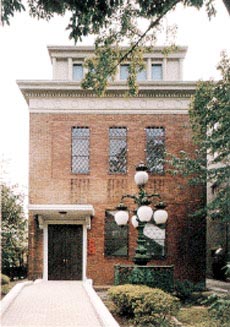 |
Here and There introduces art, artists, galleries and museums around Japan that non-Japanese readers and first-time visitors may find of particular interest. The writer claims no art expertise, just a subjective viewpoint acquired over many years' residence in Japan. |
|
|
 |
 |
 |
One Hundred Views of Edo, and Then Some
Alan Gleason |
 |
 |
 |
 |
| The Chinretsukan Gallery (built in 1929) on the Geidai campus |
 |
What more appropriate spot for an exhibit of a hundred scenes of Shogun-era Tokyo than the museum at the city's leading art school, right on the edge of the old neighborhood of Yanaka?
The Museum at the Tokyo National University of Fine Arts and Music (Geidai for short) is just a short stroll from the big museum complex in Ueno Park. Yet even on a hot summer Sunday with a couple of top-notch shows on concurrent display, it was much less crowded than its massive, somewhat overwhelming neighbors. The main building is a roomy, attractively modern structure, built in 1999 to accommodate Geidai's ever-growing collection -- at 28,000 works and counting, one of Japan's largest. Given Geidai's reputation as the flagship of Japanese art schools, perhaps this should not be a surprise. (For a delightful contrast, check out the adjoining Chinretsukan gallery, an old, two-story red-brick building that is still used to exhibit student works.)
The surrounding Yanaka district, mercifully spared the fire bombings that leveled Tokyo during World War II, is still home to a number of well-preserved wooden structures dating back to the Edo era. So it seemed fitting that the Geidai Museum was displaying woodblock master Utagawa Hiroshige's last great landscape series, the Meisho Edo Hyakkei or "One Hundred Famous Views of Edo." A favorite of old/new, Edo/Tokyo buffs, the series has spawned a mini-industry of books and tours that juxtapose the scenes portrayed by Hiroshige with the sites as they appear today. Taking the time to savor all 118 of the "Hundred Views" is a soothing experience, for if Hiroshige's eye is to be trusted, Edo was surely one of the loveliest metropolises on Earth, or at least one of the greenest and wateriest.
Perhaps thanks to the local angle, this show drew larger crowds than the arguably rarer and more awe-inspiring exhibit down the hall: "The Mural Art of Kotohira-gu Shrine." Perched atop a mountain overlooking the Inland Sea, Kotohira is one of Japan's most popular pilgrimage destinations. In the old days the priests outdid themselves to accommodate visiting nobility, furnishing their quarters with some of the most exquisitely painted sliding screens you will ever see. Unfortunately the rooms are rarely open to the public, but the Geidai exhibit has lovingly reproduced the ambience of the shrine's inner sanctum, tatami matting and all. A stroll through these chambers, their walls festooned with mountains, waterfalls, tigers, cranes, and frolicking Chinese sages painted by such masters as Kano Eitoku, Ito Jakuchu, and Maruyama Okyo, is a sublime experience.
Whether your taste in landscapes runs to the grand and spiritually uplifting, or to the more mundane and humorous, either of these two shows is well worth a visit; it is almost an embarrassment of riches to be able to enjoy them in a single outing. Both exhibitions run until September 9.
|
|
|
|
|
|
|
| "Night View of Saruwaka-cho" by Utagawa Hiroshige (1856), one of the "100 Famous Views of Edo" |
|
From the "Tigers" series by Maruyama Okyo (1787), screen painting at Kotohira-gu Shrine, Shikoku |
All images courtesy of The University Art Museum
|
|
 |
|
|
 |
The University Art Museum, Tokyo National University of Fine Arts and Music |
 |
http://www.geidai.ac.jp/museum/ |
 |
12-8 Ueno Park, Taito-ku, Tokyo
Phone: 050-5525-2200 |
|
Open daily 10-5 (closed Mondays and during year-end holidays)
Transportation: 10 minutes walk from Ueno station (JR Yamanote Line) or Nezu station (Chiyoda subway line) |
 |
|
 |
 |
Alan Gleason
Alan Gleason is a translator, editor and writer based in Tokyo, where he has lived for 22 years. In addition to writing about the Japanese art scene he has edited and translated works on Japanese theater (from kabuki to the avant-garde) and music (both traditional and contemporary). |
|
|
|
 |
|